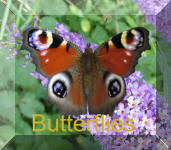ABH 59.027 |
Small Tortoiseshell Aglais urticae
|
BF 1109 |
|
|
| Back To |
(Linnaeus (1758) |
|
|

|
|
Phenology |
JAN |
FEB |
MAR |
APR |
MAY |
JUN |
JUL |
AUG |
SEP |
OCT |
NOV |
DEC |
|
| |
Family
|
Nymphalidae: |
|
|
|
Wingspan
|
Medium
to large; wingspan, 50-55 mm. |
| |
|
Description
|
Both sexes are
a bright orange-red on their upper surfaces with dark bars across
the leading edge of the forewings and darkly bordered, blue spots
along the outer margins of both wings. There are three near-black
spots on each forewing and the basal halves of the hind wings are
similarly coloured. The undersides of the wings are a dull, dark,
grey-brown colour basally with the outer half of the wings largely
a pale, dirty cream-brown. There is a row of blue-grey spots bordering
both under-wings forming an irregular band to the immediate inside
of a dirty pale brown margin.
|
| |
|
Life Cycle
|
This butterfly
wanders prolifically over a wide area and does not form colonies
but is most likely to be found in the vicinity of its principal
larval food plant, the Common Nettle, Urtica dioica. The
Small Tortoiseshell over-winters as an adult and emerges from early
March onwards before laying its eggs in late April and May. The
first brood are on the wing in July and the second brood emerges
in early September.Aassociated with highly
modified grasslands, gardens and derelict, disturbed sites.The adult
butterflies can be seen at any time of the year, even on the last
days of December or first days of January if the temperature is
high enough to wake them from hibernation. However, adults normally
emerge from hibernation at the end of March and start of April.
There are typically 2 broods each year, except in the north, where
there is usually only a single brood. Whether single or double-brooded,
the butterfly is a familiar sight in late summer as it takes nectar
to build up essential fats in preparation for hibernation.
|
| |
Habitat |
It can be found anywhere
in the city particularly in the vicinity of nettles. It is commonly
attracted to gardens seeking nectar from flowers and is one of the
most common visitors to the Butterfly-bush, Buddleja davidii. In the
open countryside it favours overgrown hedgerows and sheltered woodland
edges, rides and glades. Adults are highly mobile,
moving steadily across the countryside. Adults aggregate on nectar
sources and clumps of foodplants. After spring emergence, males form
territories around a patch of foodplant and chase any other adults
seen. Territories will be abandoned if no female is encountered within
c 90 minutes. When a female is found, a prolonged chase ensues, before
mating . Nnew generation adults feed on nectar sources prior to entering
hibernation. A wide range of flowers are used including many wild,
garden and exotic species especially Buddleja Buddleja davidii, Michaelmas
Daisies Aster spp. and Valerians Centranthus spp. The larval foodplants
are nettles Urtica spp. |
| |
|
Links |
Abberants
 |
| |
|
Images |
|
| |
|
|